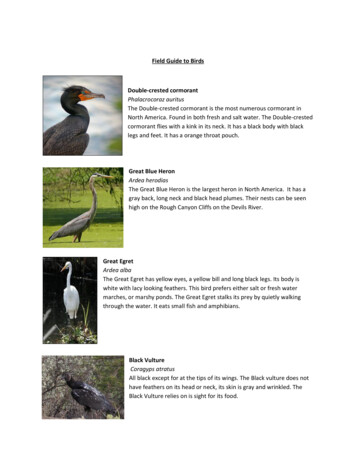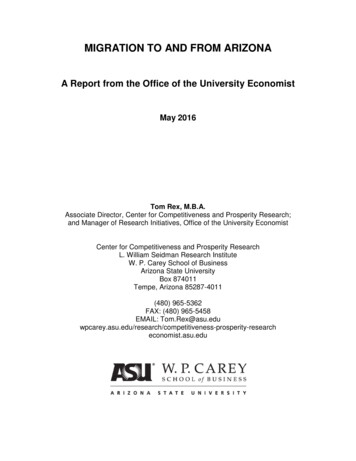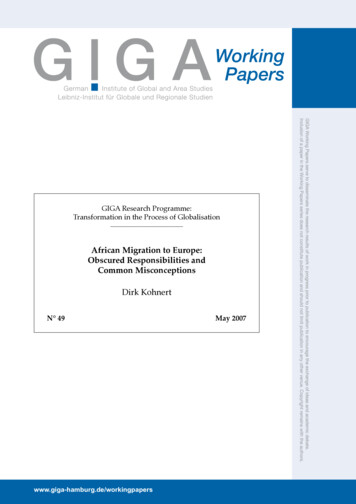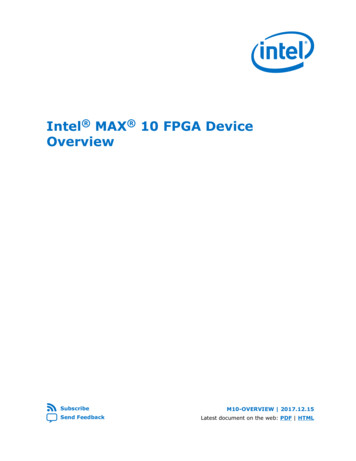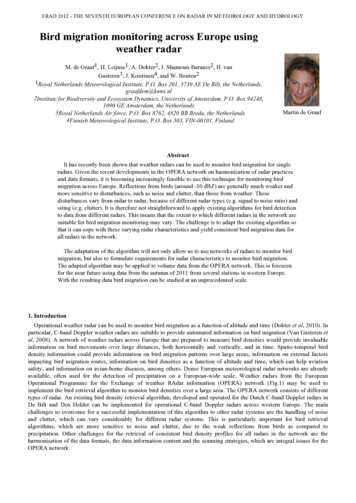
Transcription
ERAD 2012 - THE SEVENTH EUROPEAN CONFERENCE ON RADAR IN METEOROLOGY AND HYDROLOGYBird migration monitoring across Europe usingweather radarM. de Graaf1, H. Leijnse1, A. Dokter2, J. Shamoun-Baranes2, H. vanGasteren3, J. Koistinen4, and W. Bouten21Royal Netherlands Meteorological Institute, P.O. Box 201, 3730 AE De Bilt, the Netherlands,graafdem@knmi.nl2Institute for Biodiversity and Ecosystem Dynamics, University of Amsterdam, P.O. Box 94248,1090 GE Amsterdam, the Netherlands3Royal Netherlands Air force, P.O. Box 8762, 4820 BB Breda, the Netherlands4Finnish Meteorological Institute, P.O. Box 503, FIN-00101, FinlandMartin de GraafAbstractIt has recently been shown that weather radars can be used to monitor bird migration for singleradars. Given the recent developments in the OPERA network on harmonization of radar practicesand data formats, it is becoming increasingly feasible to use this technique for monitoring birdmigration across Europe. Reflections from birds (around -10 dBZ) are generally much weaker andmore sensitive to disturbances, such as noise and clutter, than those from weather. Thesedisturbances vary from radar to radar, because of different radar types (e.g. signal to noise ratio) andsiting (e.g. clutter). It is therefore not straightforward to apply existing algorithms for bird detectionto data from different radars. This means that the extent to which different radars in the network aresuitable for bird migration monitoring may vary. The challenge is to adapt the existing algorithm sothat it can cope with these varying radar characteristics and yield consistent bird migration data forall radars in the network.The adaptation of the algorithm will not only allow us to use networks of radars to monitor birdmigration, but also to formulate requirements for radar characteristics to monitor bird migration.The adapted algorithm may be applied to volume data from the OPERA network. This is foreseenfor the near future using data from the autumn of 2011 from several stations in western Europe.With the resulting data bird migration can be studied at an unprecedented scale.1. IntroductionOperational weather radar can be used to monitor bird migration as a function of altitude and time (Dokter et al, 2010). Inparticular, C-band Doppler weather radars are suitable to provide automated information on bird migration (Van Gasteren etal, 2008). A network of weather radars across Europe that are prepared to measure bird densities would provide invaluableinformation on bird movements over large distances, both horizontally and vertically, and in time. Spatio-temporal birddensity information could provide information on bird migration patterns over large areas, information on external factorsimpacting bird migration routes, information on bird densities as a function of altitude and time, which can help aviationsafety, and information on avian-borne diseases, among others. Dense European meteorological radar networks are alreadyavailable, often used for the detection of precipitation on a European-wide scale. Weather radars from the EuropeanOperational Programme for the Exchange of weather RAdar information (OPERA) network (Fig.1) may be used toimplement the bird retrieval algorithm to monitor bird densities over a large area. The OPERA network consists of differenttypes of radar. An existing bird density retrieval algorithm, developed and operated for the Dutch C-band Doppler radars inDe Bilt and Den Helder can be implemented for operational C-band Doppler radars across western Europe. The mainchallenges to overcome for a successful implementation of this algorithm to other radar systems are the handling of noiseand clutter, which can vary considerably for different radar systems. This is particularly important for bird retrievalalgorithms, which are more sensitive to noise and clutter, due to the weak reflections from birds as compared toprecipitation. Other challenges for the retrieval of consistent bird density profiles for all radars in the network are theharmonisation of the data formats, the data information content and the scanning strategies, which are integral issues for theOPERA network.
ERAD 2012 - THE SEVENTH EUROPEAN CONFERENCE ON RADAR IN METEOROLOGY AND HYDROLOGYFigure 1. Operational European weather radars2. Bird density retrieval algorithmA bird density retrieval algorithm for C-band Doppler radar was developed for the Dutch weather radars in De Bilt andDen Helder (Dokter, 2009). The algorithm uses several filters to distinguish between precipitation, insect and bird echoes.2.1 Reflectivity filterThe reflectivity factor Z from bird scattering is typically low, in the order of about -10 to 10 dBZe for C-band radars. Ingeneral, reflectivity factors from precipitation are much higher, but both insects and precipitation can also give rise to signalssimilar in strength to those from birds. Therefore, additional filters are needed to distinguish birds from other scatterers.In order to filter strong precipitation areas, a reflectivity threshold is used. All range gates with a reflectivity higher than0 dBZ are considered to contain precipitation, with the additional criterion that at least 5 neighbouring range gates alsocontain a reflectivity higher than this threshold. The latter 'uniform filling' criterion ensures that only cells are selected asprecipitation which are uniformly filled. This uniformity is often observed for areas with precipitation, but often not for areaswith birds.All range gates that were not (yet) identified as precipitation areas on the basis of the reflectivity threshold are furtherfiltered on velocity variation, which is different for precipitation, birds, and insects.2.2 Velocity variation filterIn addition to reflectivity filtering, a filter is applied to the Doppler radial velocity variation field. Typically, areas ofprecipitation show a radial velocity vr that is spatially continuous and locally homogenous. The speed of hydrometeors isdetermined by the wind field and the terminal velocity, which are usually spatially smooth variables, except in the case ofstrong convective systems. Similarly, insects and other, passive, scatterers that can be lifted into the air by convection duringclear weather, produce radial velocities that are completely determined by the wind velocity. This is because insects haveactive flight speeds that are either negligible or non-directional on average.
ERAD 2012 - THE SEVENTH EUROPEAN CONFERENCE ON RADAR IN METEOROLOGY AND HYDROLOGYBird migration, on the other hand, gives rise to a much greater variation in the radial velocity field. Active flight frombirds may vary in speed and direction for individual birds, while the individual direction of flight is mostly independent fromthe wind direction. Therefore, the radial velocity for birds has a higher degree of (local) spatial variation. Furthermore,migrating birds give rise to scattered groups of range gates with valid data, causing the radial velocity field to beinhomogeneously filled (Dokter et al, 2009).The variation in radial velocity is quantified by determining the local standard deviation σv of vr for each considered rangegate, using its 8 direct neighbours. The difference in reflectivity factor Z, the radial velocity vr and the local standarddeviation in radial velocity σv is illustrated in Fig.2 for precipitation, insects and birds.(a) Z (precipitation)(b) vr (precipitation)(d) Z (clear air)(e) vr (clear air)(g) Z (birds)(h) vr (birds)(c) σv (precipitation)(f) σv (clear air)(i) σv (birds)Figure 2. Reflectivity factor Z (left), radial velocity vr (middle) and radial velocity standarddeviation σv (right) Plan Position Indicators (PPIs) for a case of precipitation (a,b,c), a case ofclear air without birds during daytime (d,e,f) which are probably caused by insects, and a case ofintense bird migration (g,h,i) (Dokter et al, 2009).
ERAD 2012 - THE SEVENTH EUROPEAN CONFERENCE ON RADAR IN METEOROLOGY AND HYDROLOGY3. Clutter3.1 Static clutter mapsClutter filtering is particularly important for the correct determination of the weak bird reflections. Currently, a staticclutter map is implemented in the bird retrieval algorithm, valid for De Bilt and Den Helder only. All pixels with reflectivityvalues exceeding a certain threshold (-10 dBZ) are identified as clutter and rejected for the retrieval of birds. This ensuresthat ground clutter will have a limited effect on retrieved bird densities. The static clutter map was constructed by averagingall clutter-corrected reflectivity values of a given radar pixel over a given dry period. This dry period should be carefullyselected so that no significant influence of insects or birds is expected. The current clutter map was created usingreflectivities averaged over 14-19 February 2008. The static clutter map should be updated regularly (e.g. once per year), asbuildings may be erected or demolished. This requires manual selection of dry periods, which can be time-consuming. Thisis close to impossible when the method is applied to data from the approximately 200 radars in the OPERA network.3.2 Dynamic clutter mapsAn alternative method of constructing clutter maps is by using long-term statistics of reflectivity (Donaldson, 2010). Theadvantage of this is that it can be done automatically. The basic assumption behind this method is that at least a certainpercentage of the time the radar data are not affected by precipitation, insects, or birds. The clutter map can then be definedas the 25th percentile, median (i.e. 50th percentile), or mode of the reflectivity values of each pixel. These statistics are allinsensitive of the values of the higher reflectivities. We use uncorrected reflectivity for this purpose as we would like toensure that the Doppler clutter filter applied to the data has limited influence on the retrieved bird densities.Figure 3 shows an example of the probability density function of the uncorrected reflectivity of a pixel from the radar inDe Bilt for the year 2011 and the month of April 2012. Also shown in this figure are the 25th percentile, mode, and mediancorresponding to the 2011 data. The figure clearly shows the peak caused by clutter around -10 dBZ, and the signals fromprecipitation above these values. It is also shown that the probability density over a given month is very similar to that takenover an entire year. This means that this method could be applied to 1-month statistics without losing robustness. Forrobustness we select the mode as the statistic to use for construction of the clutter maps. Figure 3 shows that this is veryclose to both the 25th and 50th percentiles.0.14The effect of the old static and new dynamic clutter maps is shown in Figure 4. It shows the bird density retrievals for theDe Bilt radar from 25 to 31 May 2012 using (a) the old static clutter map and (b) the dynamic clutter map, that was createdusing the mode of all 2011 data. The effect of the dynamic clutter map is to remove all signals in the lowest elevations, soeffectively the radar becomes blind to bird movements below about 200 m. These signals are mainly caused by clear-airechoes from insects in the summer months. This means that the 2011 mode is a too severe condition to serve as a clutterfilter in this case.0.080.060.000.020.04probability density0.100.12PDF over 2011PDF over April 201225th percentile (2011)median (2011)mode (2011) 2002040dBZFig 3. Probability density function of the uncorrected reflectivity of a radar pixel (elevation 1.1degrees, azimuth 61 degrees, range 6.5 km) of the radar in De Bilt for the year 2011 (solid blackline) and the month of April 2012 (solid grey line). The mode, median and 25th percentile for theyear 2011 are shown by the dashed blue line, solid green line and solid red line, respectively.
ERAD 2012 - THE SEVENTH EUROPEAN CONFERENCE ON RADAR IN METEOROLOGY AND HYDROLOGY(a) Bird density with static clutter map(b) Bird density with dynamic clutter mapFig 4. Bird density height profiles (top) and height integrated bird densities from the De Bilt radarfrom 25 to 31 May 2012, using (a) the static clutter map and (b) the dynamic clutter map, createdusing the mode of all 2011 data. The grey areas indicate the time between sunset and sunrise.ConclusionsThe ongoing efforts within the European OPERA weather radar network provide opportunities for bird migrationmonitoring across Europe. Synchronisation of data formats and scanning strategies helps the consistent retrieval of birddensity estimates from various radar systems along the migration routes. Bird reflections are generally weak, so the correctfiltering of clutter is particularly important for the retrieval of bird density estimates. Here, we investigated the use of adynamic clutter map, based on the mode of all data from 2011 for each radar pixel. The effect of this clutter map was therejection of most of the pixels near the ground and near the radar, effectively making the radar 'blind' for bird movementsnear the surface. Therefore, new ways for dynamic and automatic clutter filtering must be explored in order to providereliable bird density estimates from weather radar data.AcknowledgmentThis research was carried out as part of the Flysafe-2 project, financed by the Royal Netherlands Air Force.ReferencesDokter, A.M., Liechti F., and Holleman I., 2009: Bird detection by operational weather radar. KNMI scientific report, 2009-06, 202 er, A.M., Liechti F., Stark, H., Delobbe, L., Tabary, P., and Holleman I., 2010: Bird migration flight altitudes studied by a network ofoperational weather radars. J. R. Soc. Interface, 8, doi: 10.1098/rsif.2010.0116Donaldson, N., 2010: Monitoring Canadian weather radars with operational observations. Proceedings of the Sixth EuropeanConference on Radar in Meteorology and Hydrology, Sibiu, Romania, paper 292.Van Gasteren, H., Holleman I., Bouten, W., Van Loon, E., Shamoun-Baranes, J., 2008: Extracting bird migration information from Cband Doppler weather radars, Ibis, 150, 674–686
1090 GE Amsterdam, the Netherlands 3Royal Netherlands Air force, P.O. Box 8762, 4820 BB Breda, the Netherlands 4Finnish Meteorological Institute, P.O. Box 503, FIN-00101, Finland Martin de Graaf Abstract It has recently been shown that weather radars can be used to monitor bird migration for single radars.

